BUICK CENTURY 1994 Service Manual
Manufacturer: BUICK, Model Year: 1994, Model line: CENTURY, Model: BUICK CENTURY 1994Pages: 308, PDF Size: 16.3 MB
Page 41 of 308
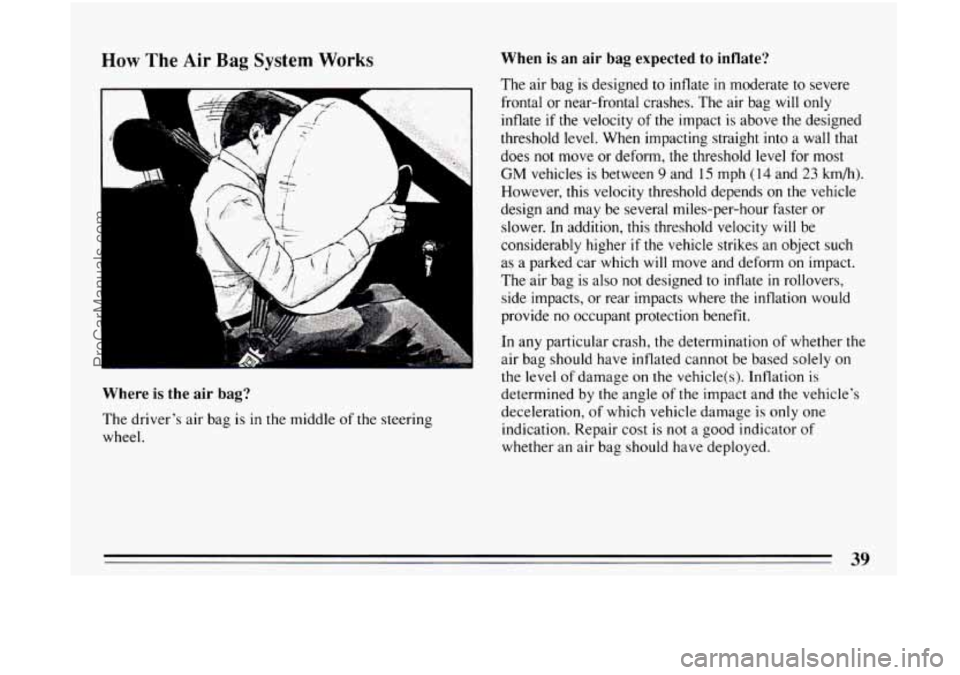
How The Air Bag System Works When is an air bag expected to inflate?
Where is the air bag?
The driver’s air bag is in the middle of the steering
wheel. The air
bag is designed to inflate
in moderate to severe
frontal or near-frontal crashes. The air bag
will only
inflate
if the velocity of the impact is above the designed
threshold level. When impacting straight into a wall that
does
not move or deform, the threshold level for most
GM vehicles is between 9 and 15 mph (1 4 and 23 km/h).
However, this velocity threshold depends
on the vehicle
design and may be several miles-per-hour faster or
slower. In addition, this threshold velocity will be
considerably higher
if the vehicle strikes an object such
as a parked car which will move and deform on impact.
The air bag is also
not designed to inflate in rollovers,
side impacts, or rear impacts where the inflation would
provide no occupant protection benefit.
In any particular crash, the determination of whether
the
air bag should have inflated cannot be based solely on
the level of damage on the vehicle(s). Inflation is
determined by the angle of the impact and the vehicle’s
deceleration, of which vehicle damage
is only one
indication. Repair cost
is not a good indicator of
whether an air bag should have deployed.
39
ProCarManuals.com
Page 42 of 308
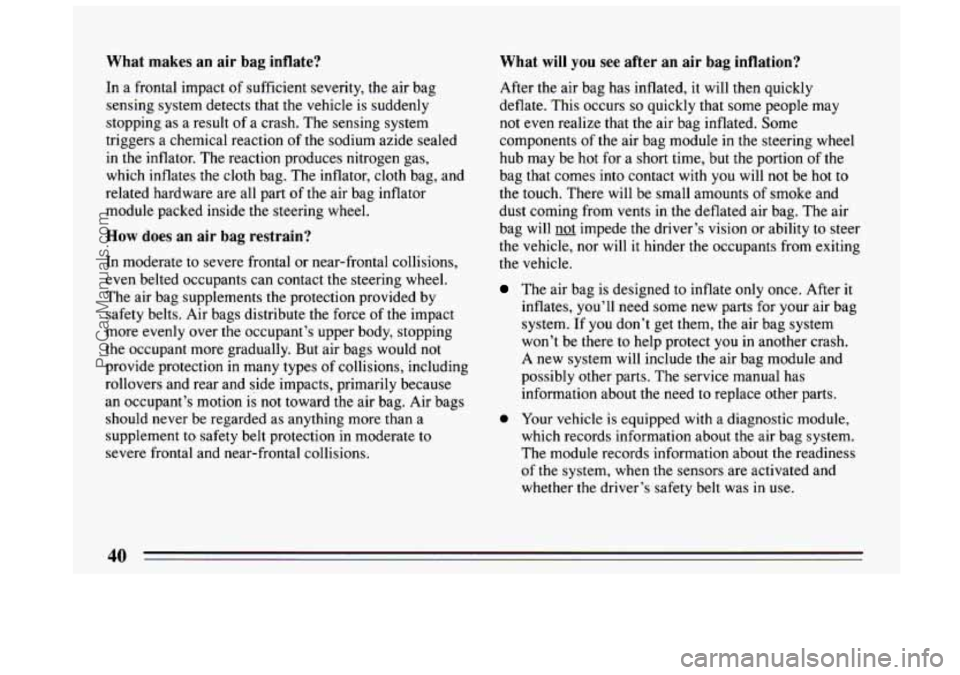
What makes an air bag inflate?
In a frontal impact of sufficient severity, the air bag
sensing system detects that the vehicle is suddenly
stopping as a result of a crash. The sensing system
triggers a chemical reaction
of the sodium azide sealed
in the inflator. The reaction produces nitrogen gas,
which inflates the cloth bag. The inflator, cloth bag, and
related hardware are all part
of the air bag inflator
module packed inside the steering wheel.
How does an air bag restrain?
In moderate to severe frontal or near-frontal collisions,
even belted occupants can contact the steering wheel.
The air bag supplements
the protection provided by
safety belts. Air bags distribute the force of the impact
more evenly over the occupant’s upper body, stopping
the occupant more gradually. But air bags would not
provide protection in many types
of collisions, including
rollovers and rear and side impacts, primarily because
an occupant’s motion is not toward the air bag. Air bags
should never be regarded as anything more than a
supplement to safety belt protection in moderate
to
severe frontal and near-frontal collisions.
What will you see after an air bag inflation?
After the air bag has inflated, it will then quickly
deflate. This occurs
so quickly that some people may
not even realize that the air bag inflated. Some
components of the air bag module in the steering wheel
hub may be hot for a short time, but the portion of the
bag that comes into contact with
you will not be hot to
the touch. There will be small amounts of smoke and
dust coming from vents in the deflated air bag. The air
bag will
not impede the driver’s vision or ability to steer
the vehi,cle, nor will it hinder the occupants from exiting
the vehicle.
The air bag is designed to inflate only once. After it
inflates, you’ll need some new parts for your air bag
system. If you don’t get them, the air bag system
won’t be there to help protect you in another crash.
A new system will include the air bag module and
possibly other parts. The service manual has
information about the need to replace other parts.
0 Your vehicle is equipped with a diagnostic module,
which records information about the air bag system.
The module records information about the readiness
of the system, when the sensors are activated and
whether the driver’s safety belt was
in use.
40
ProCarManuals.com
Page 43 of 308
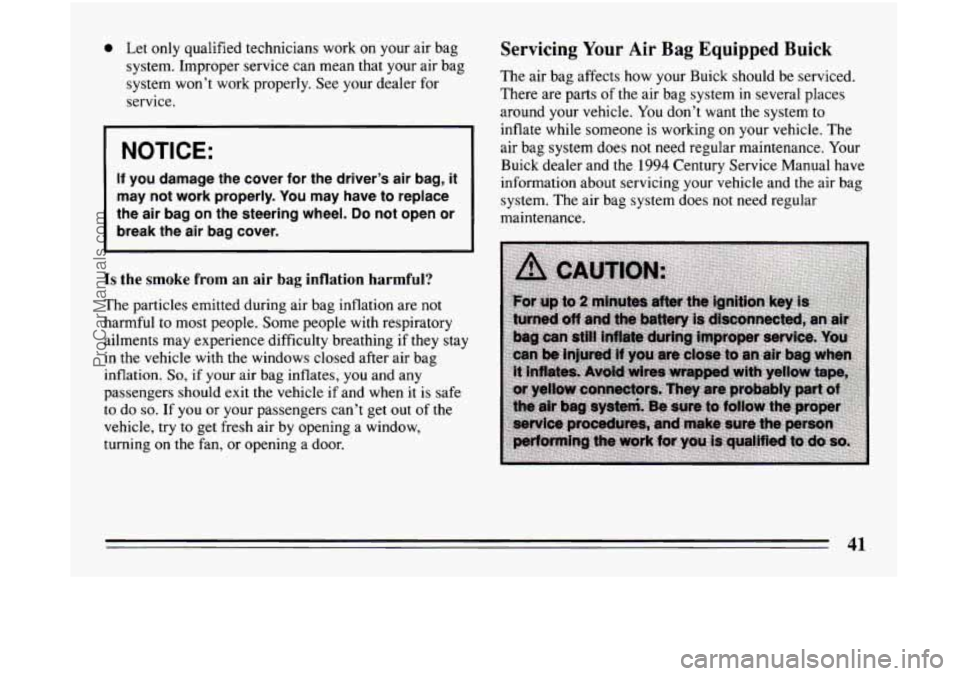
0 Let only qualified technicians work on your air bag
system. Improper service can mean that your air bag
system won’t work properly. See your dealer for
service.
NOTICE:
If you damage the cover for the driver’s air bag, it
may not work properly. You may have to replace
the air bag on the steering wheel.
Do not open or
break the air bag cover.
Is the smoke from an air bag inflation harmful?
The particles emitted during air bag inflation are not
harmful to most people. Some people with respiratory
ailments may experience difficulty breathing if they stay
in the vehicle with the windows closed after air bag
inflation.
So, if your air bag inflates, you and any
passengers should exit the vehicle if and when it is safe
to
do so. If you or your passengers can’t get out of the
vehicle, try
to get fresh air by opening a window,
turning on the fan, or opening a door.
Servicing Your Air Bag Equipped Buick
The air bag affects how your Buick should be serviced.
There are parts
of the air bag system in several places
around your vehicle. You don’t want the system to
inflate while someone is working on your vehicle. The
air bag system does not need regular maintenance. Your
Buick dealer and the
1994 Century Service Manual have
information about servicing your vehicle and the air bag
system. The air bag system does not need regular
maintenance.
41
ProCarManuals.com
Page 44 of 308
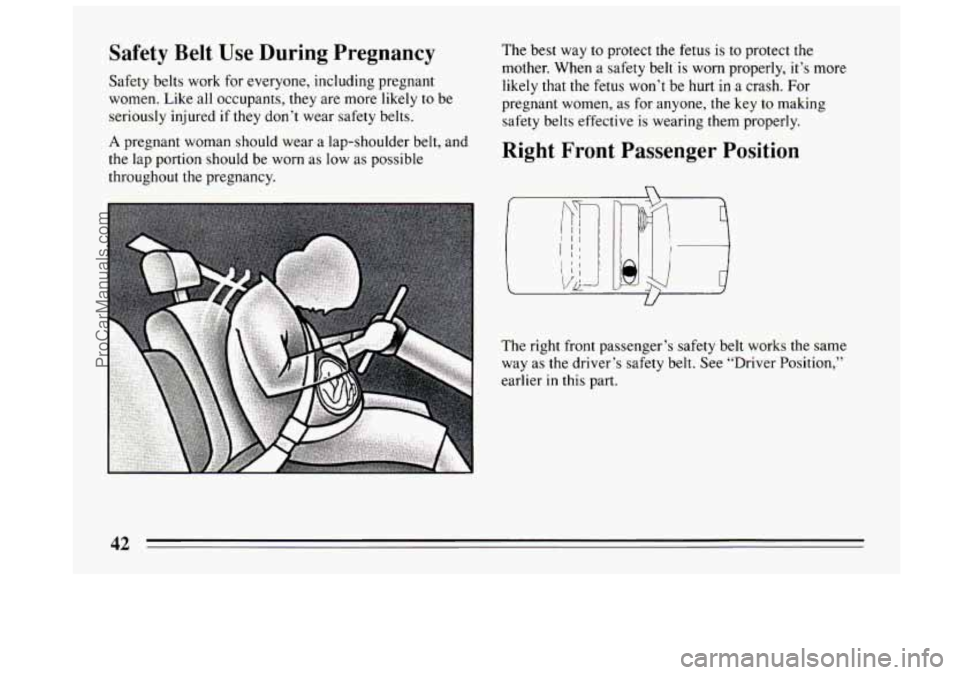
Safety Belt Use During Pregnancy
Safety belts work for everyone, including pregnant
women. Like all occupants, they are more likely to be
seriously injured
if they don’t wear safety belts.
A pregnant woman should wear a lap-shoulder belt, and
the lap portion should be worn as low as possible
throughout the pregnancy. The
best way to protect
the fetus is to protect the
mother. When a safety belt is worn properly, it’s more
likely
that the fetus won’t be hurt in a crash. For
pregnant women,
as for anyone, the key to making
safety belts effective
is wearing them properly.
Right Front Passenger Position
The right front passenger’s safety belt works the same
way as the driver’s safety belt. See “Driver Position,”
earlier
in this part.
42
ProCarManuals.com
Page 45 of 308
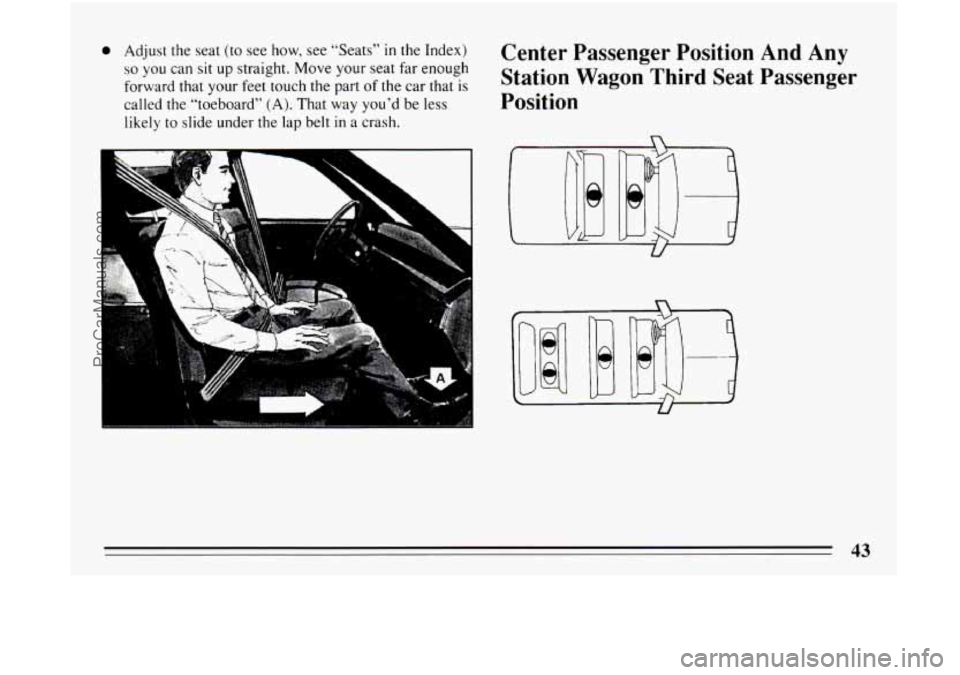
0 Adjust the seat (to see how, see “Seats” in the Index)
so you can sit up straight. Move your seat far enough
forward that your feet touch the part
of the car that is
called the “toeboard” (A). That way you’d be less
likely
to slide under the lap belt in a crash.
- I
Center Passenger Position And Any
Station Wagon Third Seat Passenger
Position
U
n
ProCarManuals.com
Page 46 of 308
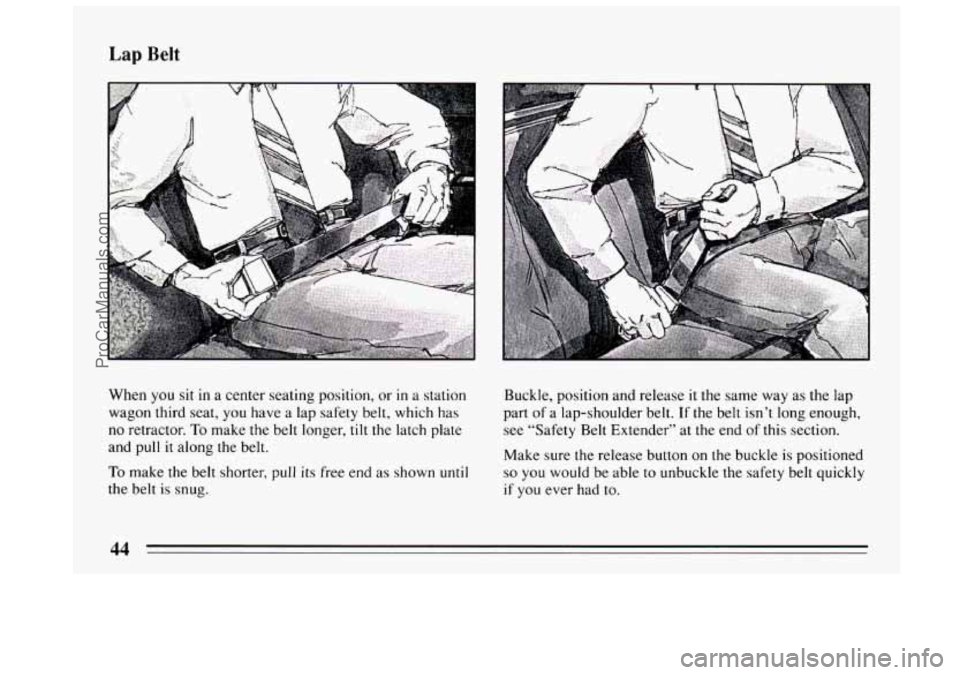
Lap Belt
When you sit in a center seating position, or in a station
wagon third seat,
you have a lap safety belt, which has
no retractor.
To make the belt longer, tilt the latch plate
and pull
it along the belt.
To make the belt shorter, pull its free end as shown until
the belt is snug. Buckle, position and release
it the same way as the lap
part
of a lap-shoulder belt. If the belt isn't long enough,
see "Safety Belt Extender" at the end
of this section.
Make sure the release button on the buckle
is positioned
so you would be able to unbuckle the safety belt quickly
if you ever had to.
44
ProCarManuals.com
Page 47 of 308
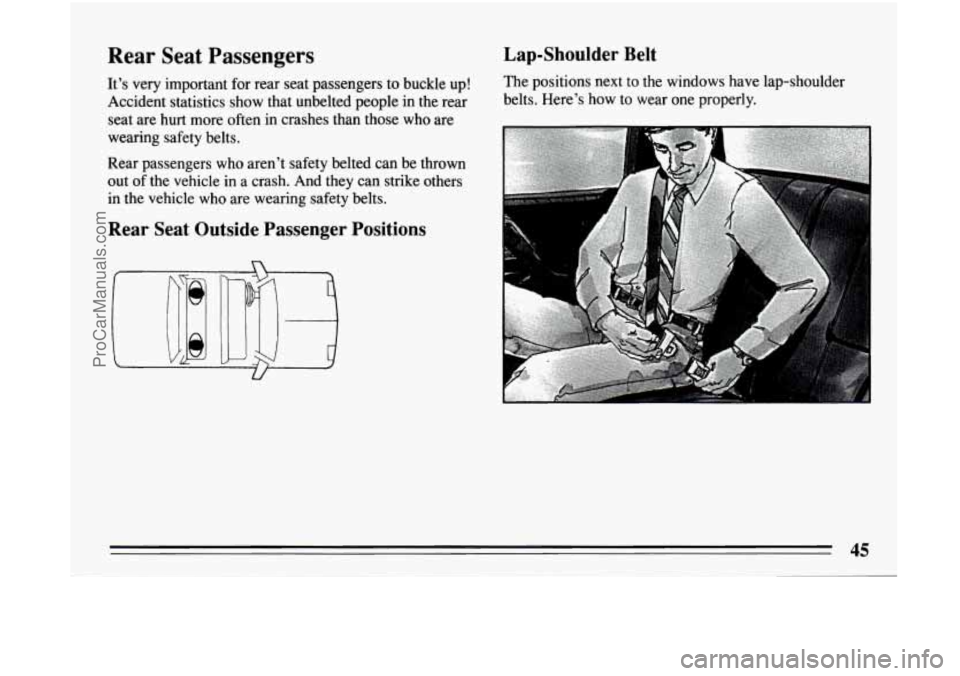
Rear Seat Passengers
It's very important for rear seat passengers to buckle up!
Accident statistics show that unbelted people in the rear
seat are
hurt more often in crashes than those who are
wearing safety belts.
Rear passengers who aren't safety belted can be thrown
out
of the vehicle in a crash. And they can strike others
in the vehicle who are wearing safety belts.
Rear Seat Outside Passenger Positions Lap-Shoulder
Belt
The positions next to the windows have lap-shoulder
belts. Here's how to wear one properly.
45
ProCarManuals.com
Page 48 of 308
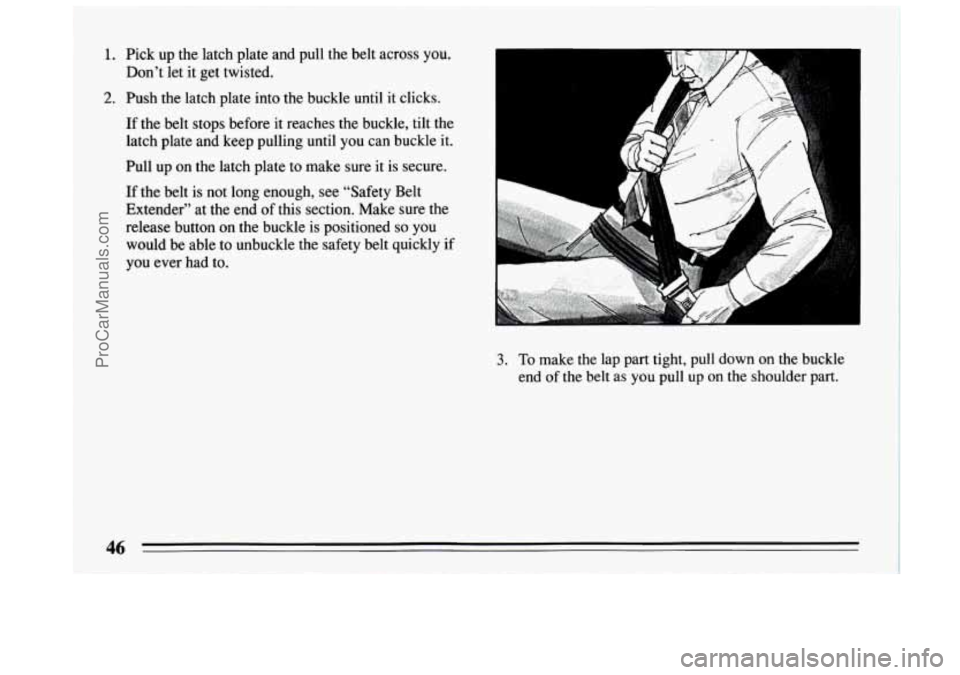
1. Pick up the latch plate and pull the belt across you.
2. Push the latch plate into the buckle until it clicks.
Don’t
let it get twisted.
If the belt stops before it reaches the buckle, tilt the
latch plate and keep pulling until you can buckle it.
Pull up on the latch plate to make sure it is secure.
If the belt
is not long enough, see “Safety Belt
Extender” at the end of this section. Make sure the
release button on the buckle is positioned
so you
would be able to unbuckle the safety belt quickly if
you ever had to.
3. To make the lap part tight, pull down on the buckle
end of the belt as you pull
up on the shoulder part.
46
!
ProCarManuals.com
Page 49 of 308
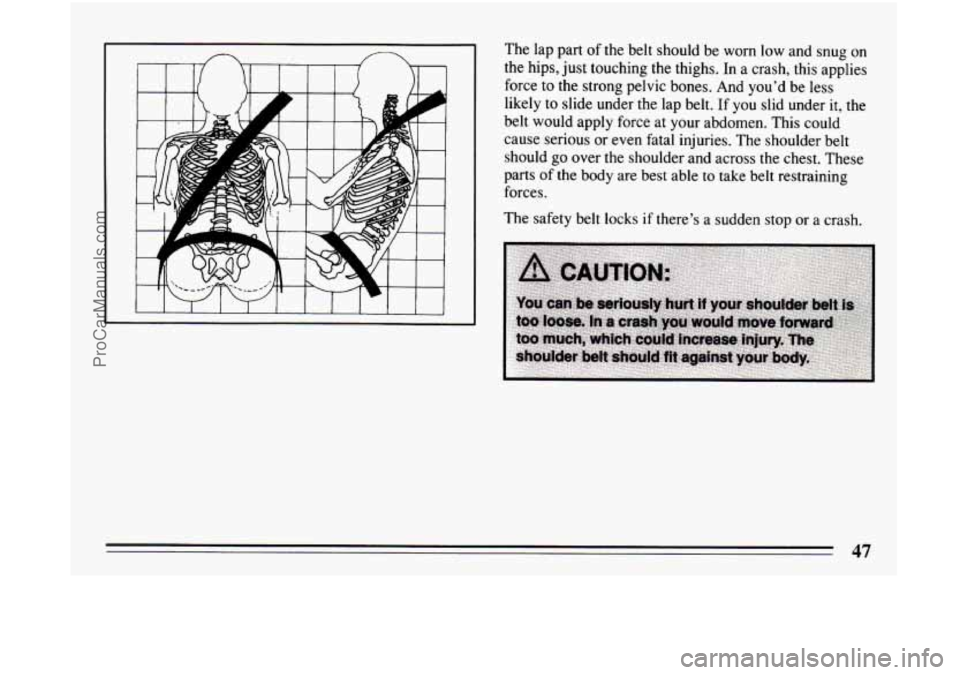
The lap part of the belt should be worn low and snug on
the hips, just touching the thighs. In a crash, this applies
force to the strong pelvic bones. And you’d be less
likely to slide under the lap belt. If you slid under
it, the
belt would apply force at your abdomen. This could
cause serious or even fatal injuries. The shoulder belt
should
go over the shoulder and across the chest. These
parts of the body are best able to take belt restraining
forces.
The safety belt locks
if there’s a sudden stop or a crash.
47
ProCarManuals.com
Page 50 of 308
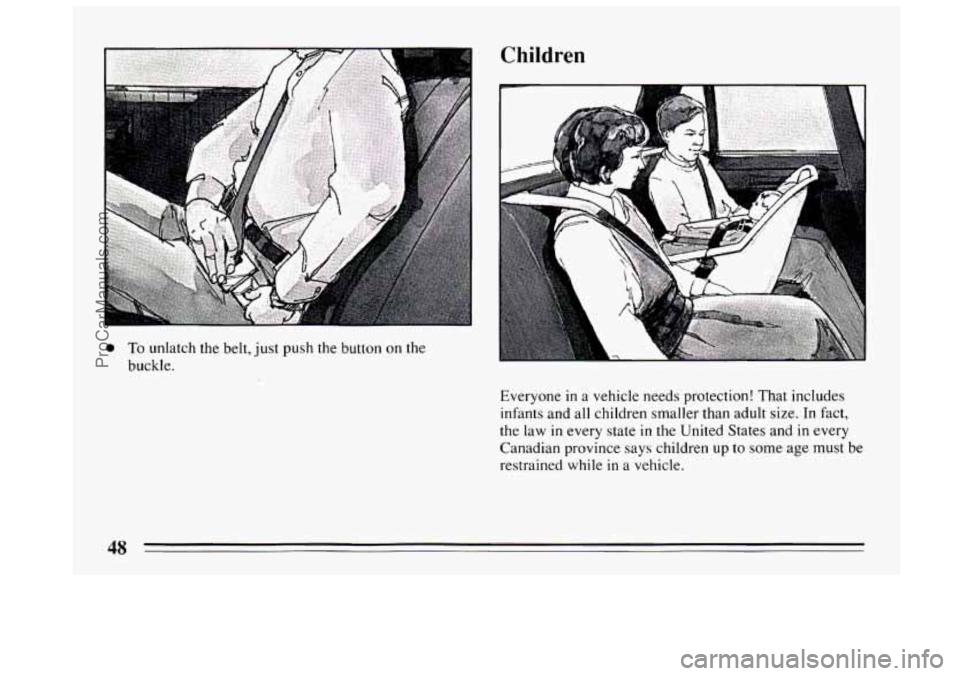
0 To unlatch the belt, just push the button on the
buckle.
Children
Everyone in a vehicle needs protection! That includes
infants and all children smaller than adult size. In fact,
the law
in every state in the United States and in every
Canadian province says children up
to some age must be
restrained while in a vehicle.
4s
ProCarManuals.com